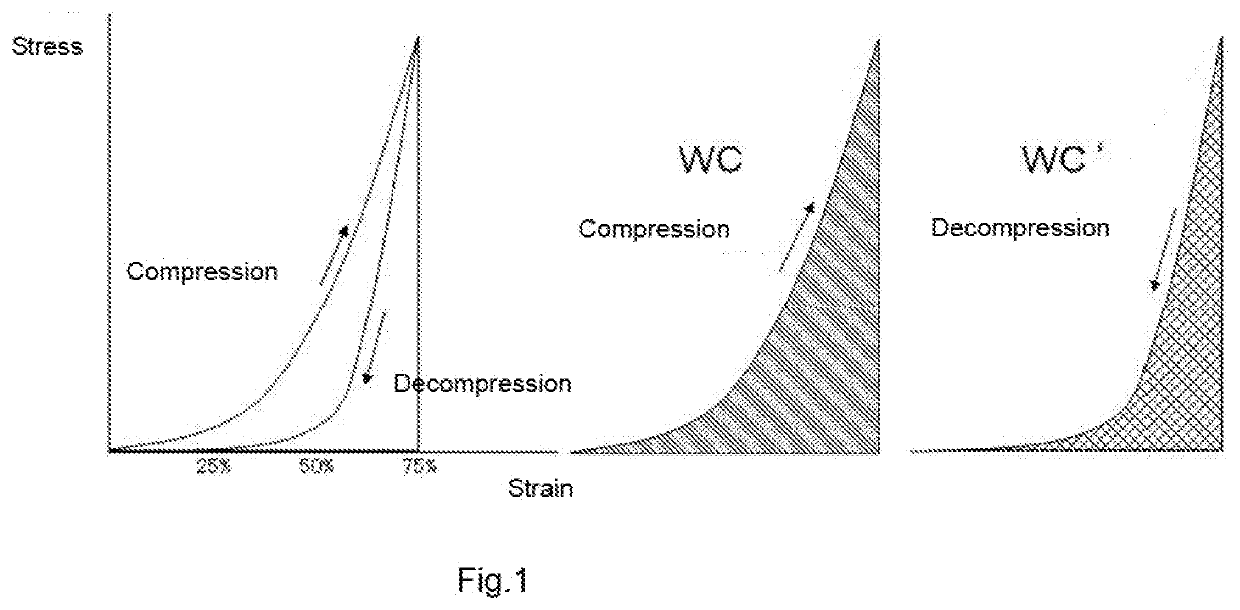Fibrous network structure having excellent compression durability
a network structure and compression durability technology, applied in the field of network structure, can solve the problems of insufficient moisture and water permeability, high cost of elimination of poisonous gas, and significant damage to incinerators, and achieve excellent repeated compression durability, low repeated compression residual strain, and high hardness retention
- Summary
- Abstract
- Description
- Claims
- Application Information
AI Technical Summary
Benefits of technology
Problems solved by technology
Method used
Image
Examples
example 1
[0066]As a polyester-based elastomer, dimethyl terephthalate (DMT) and 1,4-butanediol (1,4-BD) were charged together with a small amount of a catalyst, transesterification was performed using a usual method, polytetramethylene glycol (PTMG) was then added, and the mixture was subjected to polycondensation while the temperature was raised and the pressure was reduced, so that a polyether ester block copolymer elastomer was generated. Then, 2% of an antioxidant was added thereto, and the mixture was mixed and kneaded, then pelletized, and dried in vacuum at 50° C. for 48 hours to obtain a thermoplastic elastic resin raw material. The formulation of the obtained thermoplastic elastic resin raw material is shown in Table 1.
[0067]The obtained thermoplastic elastic resin (A-1) was discharged to downward from a nozzle at a melting temperature of 230° C. and a speed of 2.4 g / min in terms of discharge amount per single hole through orifices zigzag-arranged at a pitch between holes of 5 mm on...
example 2
[0069]A network structure was obtained in the same manner as in Example 1 except that a heat-retaining region was not provided immediately below the nozzle, the discharge amount per single hole was 4 g / min, the take-up speed was 1.5 m / min, the nozzle face-cooling water distance was 28 cm, endless nets made of stainless steel having a width of 150 cm were disposed parallel at an interval of 41 mm in opening width, and the surfaces of the conveyor nets were heated to 120° C. with an infrared heater. The obtained network structure was formed of filaments each having a triangular prism-shaped hollow cross section as a cross-sectional shape, and having a hollowness of 35% and a fineness of 2800 dtex, and had an apparent density of 0.052 g / cm, a thickness of flattened surface of 41 mm, a 70° C.-compression residual strain of 18.6%, a 50%-constant displacement repeated compression residual strain of 2.9%, a 25%-compression hardness of 220 N / φ200 mm, a 50%-compression hardness of 433 N / φ200...
example 3
[0070]A network structure was obtained in the same manner as in Example 1 except that a heat-retaining region was not provided immediately below the nozzle, the spinning temperature was 230° C., the discharge amount per single hole was 2.8 g / min, endless nets made of stainless steel having a width of 150 cm were disposed parallel at an interval of 36 mm in opening width, the conveyor nets were not heated, the surface temperature thereof was 40° C., and the temperature of cooling water was 80° C. The obtained network structure was formed of filaments each having a triangular prism-shaped hollow cross section as a cross-sectional shape, and having a hollowness of 30% and a fineness of 3000 dtex, and had an apparent density of 0.043 g / cm3, a thickness of flattened surface of 35 mm, a 70° C.-compression residual strain of 17.9%, a 50%-constant displacement repeated compression residual strain of 4.4%, a 25%-compression hardness of 155 N / φ200 mm, a 50%-compression hardness of 271 N / φ200 ...
PUM
| Property | Measurement | Unit |
|---|---|---|
| melting point | aaaaa | aaaaa |
| spinning temperature | aaaaa | aaaaa |
| length | aaaaa | aaaaa |
Abstract
Description
Claims
Application Information
 Login to View More
Login to View More - R&D
- Intellectual Property
- Life Sciences
- Materials
- Tech Scout
- Unparalleled Data Quality
- Higher Quality Content
- 60% Fewer Hallucinations
Browse by: Latest US Patents, China's latest patents, Technical Efficacy Thesaurus, Application Domain, Technology Topic, Popular Technical Reports.
© 2025 PatSnap. All rights reserved.Legal|Privacy policy|Modern Slavery Act Transparency Statement|Sitemap|About US| Contact US: help@patsnap.com

